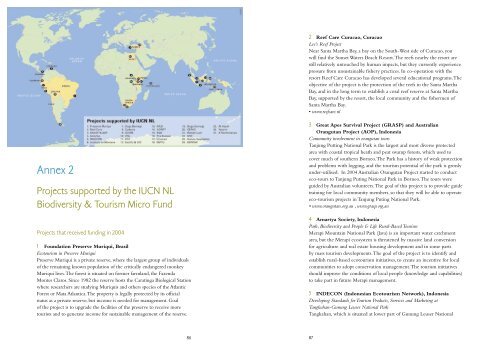OMSLAG 5.indd - IUCN
OMSLAG 5.indd - IUCN
OMSLAG 5.indd - IUCN
You also want an ePaper? Increase the reach of your titles
YUMPU automatically turns print PDFs into web optimized ePapers that Google loves.
Annex 2<br />
Projects supported by the <strong>IUCN</strong> NL<br />
Biodiversity & Tourism Micro Fund<br />
Projects that received funding in 2004<br />
1 Foundation Preserve Muriqui, Brasil<br />
Ecotourism in Preserve Muriqui<br />
Preserve Muriqui is a private reserve, where the largest group of individuals<br />
of the remaining known population of the critically endangered monkey<br />
Muriqui lives. The forest is situated on former farmland, the Fazenda<br />
Montes Claros. Since 1982 the reserve hosts the Caratinga Biological Station<br />
where researchers are studying Muriquis and others species of the Atlantic<br />
Forest or Mata Atlantica. The property is legally protected by its official<br />
status as a private reserve, but income is needed for management. Goal<br />
of the project is to upgrade the facilities of the preserve to receive more<br />
tourists and to generate income for sustainable management of the reserve.<br />
86 87<br />
2 Reef Care Curacao, Curacao<br />
Lee’s Reef Project<br />
Near Santa Martha Bay, a bay on the South-West side of Curacao, you<br />
will find the Sunset Waters Beach Resort. The reefs nearby the resort are<br />
still relatively untouched by human impacts, but they currently experience<br />
pressure from unsustainable fishery practices. In co-operation with the<br />
resort Reef Care Curacao has developed several educational programs. The<br />
objective of the project is the protection of the reefs in the Santa Martha<br />
Bay, and in the long term to establish a coral reef reserve at Santa Martha<br />
Bay, supported by the resort, the local community and the fishermen of<br />
Santa Martha Bay.<br />
• www.reefcare.nl<br />
3 Great Apes Survival Project (GRASP) and Australian<br />
Orangutan Project (AOP), Indonesia<br />
Community involvement in orangutan tours<br />
Tanjung Putting National Park is the largest and most diverse protected<br />
area with coastal tropical heath and peat swamp forests, which used to<br />
cover much of southern Borneo. The Park has a history of weak protection<br />
and problems with logging, and the tourism potential of the park is grossly<br />
under-utilised. In 2004 Australian Orangutan Project started to conduct<br />
eco-tours to Tanjung Puting National Park in Borneo. The tours were<br />
guided by Australian volunteers. The goal of this project is to provide guide<br />
training for local community members, so that they will be able to operate<br />
eco-tourism projects in Tanjung Puting National Park.<br />
• www.orangutan.org.au , www.grasp.org.au<br />
4 Amartya Society, Indonesia<br />
Park, Biodiversity and People & Life Rural-Based Tourism<br />
Merapi Mountain National Park (Java) is an important water catchment<br />
area, but the Merapi ecosystem is threatened by massive land conversion<br />
for agriculture and real estate housing development and in some parts<br />
by mass tourism developments. The goal of the project is to identify and<br />
establish rural-based ecotourism initiatives, to create an incentive for local<br />
communities to adopt conservation management. The tourism initiatives<br />
should improve the conditions of local people (knowledge and capabilities)<br />
to take part in future Merapi management.<br />
5 INDECON (Indonesian Ecotourism Network), Indonesia<br />
Developing Standards for Tourism Products, Services and Marketing at<br />
Tangkahan-Gunung Leuser National Park<br />
Tangkahan, which is situated at lower part of Gunung Leuser National
















